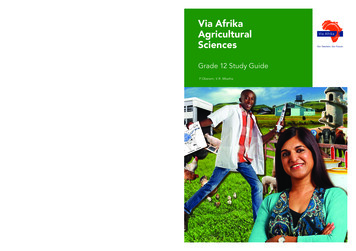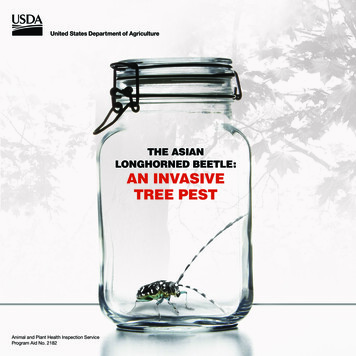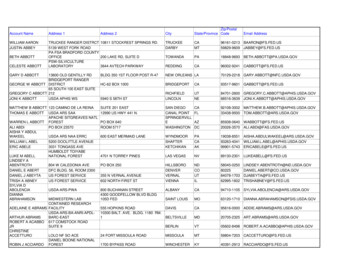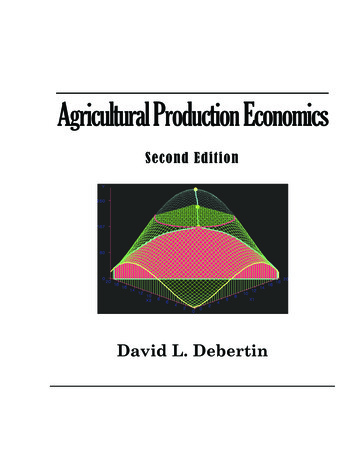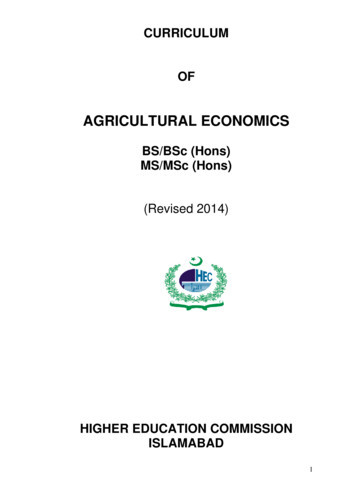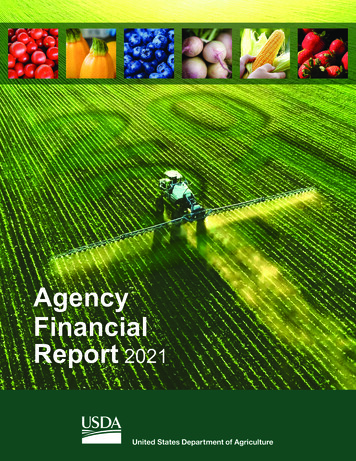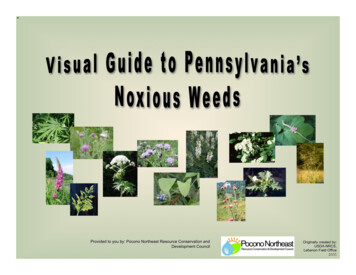
Transcription
!
Table of ContentsVegetation ManagementDepartment of HorticultureCollege of Agricultural SciencesVisual Guideto Pennsylvania's Noxious Weedscreated byLebanon County Field OfficeUSDA-Natural Resources Conservation Service2005revised 2008Penn State Vegetation Management ProjectIntroductionPennsylvania Noxious Weed Control Act .1Introduction to this Guide .1Weed Management Basics .1Noxious Weed Identification and ManagementAnnualsMarijuana (Cannabis sativa) .4Jimsonweed (Datura stramonium) .6Mile-a-minute (Polygonum perfoliatum) .8This publication's development was supported in part by a grantfrom the U.S. Department of Agriculture, Natural ResourcesConservation Service (USDA-NRCS) Harrisburg, PA. This workwas sponsored by the Pennsylvania Association of ResourceConservation & Development (RC&D) Councils and U.S.Department of Agriculture, Farm Services Agency (USDA-FSA)Harrisburg, PA. .USDA and Pennsylvania Association of RC&D Councils areequal opportunity providers and employers.Shattercane (Sorghum bicolor) .10BiennialsMusk thistle (Carduus nutans) .12Bull thistle (Cirsium vulgare) .14PerennialsCanada thistle (Cirsium arvense).16Revisions by Art Gover, 2008. The contents of this work reflect the views of the author who is responsiblefor the facts and the accuracy of the data presented herein. The contents do not necessarily reflect theofficial views or policies of the U.S. Department of Agriculture or The Pennsylvania State University at thetime of publication.Where trade names appear, no discrimination is intended, and no endorsement by the Penn State Collegeof Agricultural Sciences is implied.This publication is available in alternative media on request.The Pennsylvania State University is committed to the policy that all persons shall have equal access toprograms, facilities, admission, and employment without regard to personal characteristics not related toability, performance, or qualifications as determined by University policy or by state or federal authorities. Itis the policy of the University to maintain an academic and work environment free of discrimination,including harassment. The Pennsylvania State University prohibits discrimination and harassment againstany person because of age, ancestry, color, disability or handicap, national origin, race, religious creed,sex, sexual orientation, gender identity, or veteran status. Discrimination or harassment against faculty,staff, or students will not be tolerated at The Pennsylvania State University. Direct all inquiries regardingthe nondiscrimination policy to the Affirmative Action Director, The Pennsylvania State University, 328Boucke Building, University Park, PA 16802-5901; Tel 814-865-4700/V, 814-863-1150/TTY.Goatsrue (Galega officinalis).18Giant hogweed (Heracleum mantegazzianum).20Purple loosestrife (Lythrum salicaria).22Kudzu (Pueraria lobata) .24Multiflora rose (Rosa multiflora) .26Johnsongrass (Sorghum halepense) .28
Introduction to this GuidePennsylvania’s Noxious Weed Control Act 1982-74(selected sections)This publication provides two pages of information for each of the 13weeds designated as Noxious by the Pennsylvania Department ofAgriculture. One page features images illustrating key features to identifythe species, and the second page provides a summary of managementinformation.Section 4. Sale or Propagation.When a weed is declared noxious it shall be a violation of this act to sell,transport, plant, or otherwise propagate that weed within the Commonwealth,except that the secretary may permit exceptions for specific horticultural orexperimental use.This guide is primarily intended for participants in federally fundedconservation programs. Management recommendations will likely differfrom those provided against these weeds in crop settings. Where herbicidetrade names are used for reference, the products will be labeled forConservation Reserve Programs, fallow, or non-crop settings.Section 8. Noxious Weed Control List.The noxious weed control list shall include the following weeds:a) Cannabis sativa, commonly known as MarijuanaWeed Management Basicsb) Cirsium arvense, commonly known as Canadian thistleManagement recommendations will be based on the principles ofIntegrated Pest Management (IPM), which includec) Rosa multiflora, commonly known as Multiflora rosed) Sorghum halepense, commonly known as Johnson grass well defined land management objectives,e) Polygonum perfoliatum, commonly known as Mile-a-minutef) proper pest identification,Pueraria lobata, commonly known as Kudzu-vine knowledge of pest life cycle and biology,g) Cirsium vulgare, commonly known as Bull or Spear Thistleh) Carduus nutans, commonly known as Musk or Nodding Thistle establishment of pest thresholds to determine when management isviable,i)Sorghum bicolor, commonly known as Shattercane consideration of all available methods, andj)Datura stramonium, commonly known as Jimsonweed critical evaluation of program success.k) Lythrum salicaria, commonly known as Purple Loosestrife, includingall cultivarsl)The brief summaries provided in this publication will focus on theweed's life cycle and plant type, and the management approachesavailable.Heracleum mantegazzianum, commonly known as Giant HogweedWeed Life Cyclesm) Galega officinalis, commonly known as GoatsrueWeeds are typically classified as annual, biennial, or perennial. Thesebasic categories can be expanded to provide the following life cycles andplant types.Section 10. Penalties.Any landowner who fails to comply with an order of the secretary shall beguilty of a summary offense.Annual - a plant that lives one growing season and reproduces only byseed.Any landowner who interferes with the agents of the secretary, or with amunicipality and the discharge of its duties hereunder, shall be guilty of amisdemeanor of the third degree.(10 amended July 7, 1994, P.L. 439, No. 72)Summer annual - an annual weed that completes its life cycle between thespring and fall.Winter annual - an annual weed that overwinters, completing its life cyclebetween the fall and the spring.Biennial - a plant that overwinters after its first growing season and flowers,1
produces seed, and dies the following growing season. Biennials onlyreproduce by seed, and they must overwinter to flower. Biennialstypically germinate in the spring, and therefore live longer, grow larger,and produce more seeds than annuals.Herbicide ExamplesHerbicides are named by their common name, or active ingredient, andby the trade name. Many active ingredients are generic, and are availableas a number of nearly identical products. The following table providesproduct examples for the active ingredients named in the managementdescriptions.Perennial - a plant that lives more than two growing seasons.Herbaceous perennial - a non-woody perennial. The perennial part of theplant is underground, and gives rise to annual stems that die back atthe end of the growing season.Table 1. Examples of herbicide products listed by active ingredients. Thelisted products can be used in Conservation Reserve acres. This list is notcomprehensive for herbicides labeled for conservation reserve area, nor isit comprehensive for trade names for each active ingredient.1herbicidetrade namesformulation2,4-DBarrage HF4.7 EOpti-Amine3.8 SUnison1.74 E2,4-D aminopyralidForefront R&P3 S (2.67 0.33)2,4-D dicambaWeedmaster3.87 S (2.87 1.0)2,4-D triclopyrCrossbow3 E (2.0 1.0)aminopyralidMilestone2SclethodimEnvoy Plus0.97 ity4SglyphosateAquamaster4SAquaneat4SGlyphomate 412.8 SRodeo4SRoundup PRO3SRoundup WeatherMAX4.5 SRoundup Ultra Dry65 SPglyphosate 2,4-DCampaign2.4 S (0.9 1.5)glyphosate imazapic Journey2.25 S (1.5 0.75)metsulfuronEscort XP60 DFpendimethalinPendulum AquaCap3.8 MEsethoxydimPoast1.5 EtriclopyrGarlon 3A3SPathfinder II0.75 RTUtriclopyr clopyralidRedeem R&P3 S (2.25 0.75)Woody perennial - a perennial with persistent stems that give rise to newgrowth each spring from overwintering buds. These are trees andshrubs.Weed Control MethodsThe techniques used to manage weeds are classified as cultural,mechanical, biological, and chemical.Cultural - methods that can be described as 'indirect' weed control.Includes practices such as planting weed free seed, cleaningequipment of seed and plant propagules before it leaves weed infestedareas, and planting and establishment practices to enhance the growthof crops or competitive groundcovers.Mechanical - refers to practices such as pulling, digging, cutting, or mowing.Biological - the introduction of a pest, such as an insect or disease from thenative range of a weed that will infest the weed and reduce its vigor.Biological control is usually intended to reduce a weed populationrather than eliminate it.Chemical - the application of herbicides to control weeds. The followingterms make finer distinctions between herbicidal techniques.postemergence - application of an herbicide to an emerged plant,usually to the foliage or stems.preemergence - application of an herbicide to the soil prior togermination of the weed to prevent its establishment.non-selective - an herbicide that injures all plant typesselective - an herbicide that injures certain plant types or species,while leaving other plant types or species uninjured. The mostcommon example would be applying an herbicide to a lawn thatsuppresses 'broadleaf' weeds such as dandelions while leavingthe lawn grasses uninjured.12Formulation codes: The number indicates percent by weight for dry formulations andlbs/gallon of acid equivalent for liquids. DF dry flowable ( dispersible granule),E emulsifiable concentrate, ME micro-encapsulated, S water soluble liquid, SP watersoluble powder, RTU ready-to-use. For combination products, concentrations inparentheses are in the order of active ingredients listed in first column.
prevent seed set, but biennials typically have substantial taproots with alot of stored energy. It will take several mowings to exhaust the plant’sability to regrow and produce seed.Weed Management by Life CyclesHow you use the weed management tools at your disposal will dependon the life cycle of the target weed.Perennial WeedsAnnual WeedsIt is always important to prevent seed set, but with establishedperennials the key to successful management is to injure the vegetativepropagules - the part of the plant that produces the new growth eachyear. Common example of perennial propagules are roots – bothtaproots (dandelion) and creeping roots (Canada thistle); and rhizomes(below-ground) and stolons (above-ground), which are creeping stemsthat can produce roots or shoots.With annuals, your goal is to prevent seed production, and reduce theamount of viable seed in the soil (the seedbank).The best way to prevent establishment of annual weeds is to have acompetitive groundcover in place. In grassland plantings, a dense stand willgreatly reduce opportunities for weeds to germinate. Another way to preventestablishment of annual weeds is to apply a preemergence herbicide.Pendimethalin is an example of a preemergence herbicide that has no foliaractivity, and must be applied prior to germination and ‘rained in’ to the upperlayer of the soil be effective. The herbicide imazapic (see ‘Journey’, Table1) has foliar and soil activity, and it is pre-mixed with the foliar herbicideglyphosate. ‘Journey’ is an example of an herbicide that can be appliedafter weeds emerge, control the weeds that are present and preventsubsequent germination of annual weeds.For herbaceous perennials, and woody plants that ‘sucker’ (producenew stems from their root system) it is essential to kill the root orrhizome system of the plant. Non-suckering woody plants (such asmultiflora rose) are easier to control because if their stems are killed theroot system cannot generate replacement stems and the plant dies.Competitive groundcovers and timely cutting will reduce the vigorand spread of perennial weeds and greatly aid in control, but a trulyeffective program will include systemic herbicides to kill the undergroundpropagules.Preventive methods will greatly reduce weed establishment, but therewill likely be some escapes. It is important to keep these escapes fromproducing seed. If numbers are small, pulling is effective. Mowing annualweeds before they flower will greatly reduce the vigor of the regrowth andthe amount of seed set that they produce. Repeated mowing may preventseed-set altogether, but usually weeds will continue to regrow, and if leftuntreated, the stunted plants do end up producing a small amount of seed.Postemergence herbicides are more likely to kill the plants. Selectiveherbicides are preferred when you are controlling weeds in a desirablegroundcover, to prevent ‘holes’ in the cover that will promote more weedgrowth.Timing is critical when trying to control underground plant parts. Toget herbicide into the root system of a perennial plant, it has to beapplied at a time of year when energy (sugars) produced byphotosynthesis in the leaves is being sent to the root system. This isusually later in the growing season. Early season growth of perennialsrelies on energy stored in roots, rhizomes, and stems (woody plants) theseason before. A perennial plant cannot begin to replenish the storedenergy in its roots until there are enough leaves to support the continuedgrowth of the canopy and the roots.Biennial WeedsTreating perennials early in the season is not effective as a standalone operation because the underground parts are not injured.However, an early season cutting or herbicide application is often a veryuseful part of a multi-step control program. For example, cutting ortreating Canada thistle with herbicide at flower bud stage will preventflowering and seed set. It will not injure the root system directly, butthese operations do force the plant to expend reserve energy from theroots to produce new stems at a time when energy reserves are alreadyat a season-low. This prevents vigorous growth of the thistle rootsystem, and makes the plant more susceptible to injury from a lateseason herbicide application.Biennials can be thought of as ‘big annuals’. They reproduce only byseed, but they live longer and grow larger. The management goal withbiennials is to prevent seed set and reduce the seedbank.The same preventive methods that are effective against annuals areeffective against biennials. However, many biennials can germinatethroughout the season. Preventing establishment in the spring may stillresult in biennials becoming established in the summer or early fall.Biennials do not go dormant over the winter, and begin active growthearly in the spring. This provides a considerable window of opportunity totreat biennials with postemergence herbicides into late fall, and quite early inthe spring. The key is to control biennials before they flower. Mowing will3
marijuana (Cannabis sativa)annual forbflowering and seed OVDECpulling, mowingfoliar spray - glyphosate, 2,4-D, othersCharacteristics and ManagementCannabis will likely be present in low numbers, and therefore control isfeasible, and can be limited to postemergence practices. The simplest is topull the plants, or mow them to the ground. If you believe the plants are'ditchweed', removing and destroying the seed will suffice. If the plantswere planted as marijuana, you should contact your local law enforcementagency as the DEA tracks marijuana destruction to the individual plant.Marijuana (or marihuana) is a summer-annual dicot native to Asia. Ithas been cultivated since at least 2800 B.C. It exists as two 'forms'.'Marijuana' refers to the Cannabis grown as a source of the psychoactivedrug tetrahydrocannabinol (THC), while 'hemp' refers to Cannabis grownfor fiber, which has a very low THC content.You can treat ditchweed with foliar-applied herbicides. Cannabis willnot be that difficult to control, but large plants will probably take aconsiderable dosage to effectively control compared to seedlings or smallplants.In the guise of marijuana, Cannabis is classified as a Schedule I Drugin the U.S. Controlled Substances Act of 1970. As such, its regulation isadministered by U.S. Department of Justice, Drug Enforcement Agency(DEA). It is this status that has placed marijuana on the PA Noxious WeedList. As a weed, Cannabis has little impact on Pennsylvania agriculture ornatural resources.Table 2. Cannabis is an annual plant that typically occurs in low numbers and canbe effectively controlled by pulling or spot-treating with herbicides.treatmentdetailsThe less notorious, but more common form is hemp, a fiber crop grownthroughout the world. Hemp was a prominent fiber source in the U.S. untilthe cotton gin was invented, and was still commercially grown until thepassage of the 1937 Marihuana Tax Act in 1937. Hemp production wasreinstituted during World War II to replace natural fiber sources that wereblocked by the Japanese.hand-pullingCannabis may then appear on your property in two different forms.The less likely scenario is the occurrence of 'ditchweed', the wild form ofthe low-THC hemp grown for fiber. More likely, Cannabis will appear asmarijuana because someone identified your property as an isolatedlocation to cultivate it.foliar herbicidespot-treatment4You can pull plants as soon as you can recognize them.Remove the roots to prevent regrowth. If ripe seed arepresent, remove and destroy them. If the plants have beenplanted for drug use, notify law enforcement officials to havethem destroyed.If you find it easier to treat then pull, spot treatment with aglyphosate or 2,4-D-containing product should be effectiveand inexpensive. Product labels will provide directions formixing small-batch spot treatment mixtures to be applied on a'spray to wet' basis. Large Cannabis plants can be 10 ft tall,and would require significant spray solution. It may be easierto pull these plants or cut them at ground level.
5
jimsonweed (Datura stramonium)annual forbflowering and seed OVDECpulling, cutting, foliar herbicideCharacteristics and ManagementJimsonweed is an annual forb of the nightshade family foundthroughout the U.S., except for the northern plains and Pacific Northweststates. The origin of jimsonweed is not clear - some authors believe it isnative to North America, while others believe it to be Asian in origin. Theearliest remaining herbarium specimens are from the 1700's, and the nameis believed to be a corruption of 'Jamestown' weed. It got this name afterreports of poisoning of many British Soldiers attempting to quell Bacon'sRebellion in 1676. It is also known as thornapple, moonflower, andlocoweed.All parts of Jimsonweed are poisonous, particularly the seeds.Jimsonweed contains the toxic tropane alkaloids atropine, scopolamine,and hyoscolamine. It has a long history of use in folk medicine, as well asrecreational use (usually once) by those seeking hallucinatory experiences.It is a common reason for calls to poison control centers and visits to theemergency room.Jimsonweed emits a rank odor, has smooth, coarsely-toothed leaves,and produces showy, tubular flowers that produce spiny, egg-shaped seedpods about the size of a golf ball. The plants are variable in size accordingto growth conditions, but can easily reach 6 feet in height and producedozens to hundreds of seed pods. Jimsonweed seed can remain viable inthe soil for 100 years.Though is it certainly 'weedy', it is the poisonous nature of jimsonweedthat gives it the status of Pennsylvania Noxious Weed. Livestock typicallyavoid it, but poisoning can occur if jimsonweed is a contaminant in forage.As an annual weed, jimsonweed is not difficult to control. Isolatedplants can be pulled, or cut off at the ground before going to seed. If theplants have gone to seed but the pods have not yet opened, you can pluckthe pods and burn them to kill the seed.You can treat jimsonweed with herbicides such as glyphosate orbroadleaf herbicides containing 2,4-D. Glyphosate is non-selective and willinjure all plants contacted by the spray, while broadleaf herbicides will allowyou to selectively treat jimsonweed in grasses.Because jimsonweed seed is so long-lived, the best way to preventannual infestations is limit soil-disturbance and establish a dense,Table3. Jimsonweedis an annual forb common throughout the warmer regions ofcompetitivegroundcover.the world. Jimsonweed seed can survive in the soil for over 100 years.treatmentdetailsmechanicalSmall plants can be readily pulled. Wear gloves to preventexposure to the poisonous constituents.mowingMowing will prevent seed set, and if you can mow at groundlevel, regrowth will be prevented.postemergenceherbicideSpot treatment with glyphosate is effective any time, butneeds to be done prior to seed set. Treating plants whenthey are small will limit the damage to adjacent non-targetplants from overspray.Broadleaf herbicides containing the inexpensive ingredient2,4-D are effective, and provide selective control wherejimsonweed is growing in desirable grasses.
7
mile-a-minute (Polygonum perfoliatum)annual forbflowering and seed OVDECpreemergence herbicidepre/postemergence herbicidepulling, postemergence herbicidepulling and removing from siteThere are herbicides available that will control emerged seedlings andprovide residual control. The young vines are readily detected about amonth after germination, and can then be effectively controlled by pulling,cutting at the soil line, or postemergence herbicides. Pulling after Julyrequires removal of the plant material and seed from the site to remove theseed.Characteristics and ManagementMile-a-minute (MAM) is a summer annual vine native to East Asia. Itwas introduced to the U.S. as seed in rhododendron stock planted inPennsylvania in the late 1930's. It is indeterminate, so once floweringbegins, it continues until killing frost. The vines can reach 20 feet in length,and branch freely. Many dozens to hundreds of spherical, shiny black seedare produced per plant, surrounded by a fleshy blue covering that makesthe seed attractive to birds. The seed passes through the birds intact, andis spread in their droppings. MAM seed floats, and is readily spread alongwaterways.Table 4. Mile-a-minute is a summer annual vine that flowers from June until killingfrost. Effective control requires several years of preventing seed set to exhaust theseed bank.treatmentdetailsMAM begins to germinate fairly early, giving it a head start on otherplants. Germination can begin in late March, and usually continues throughApril. Flowering begins in June, and the first blue, fleshy fruit bearing ripeseed appear a few weeks later. The vines continue to grow and flower rightup to killing frost, meaning some seasons there might be four full months ofseed production by MAM.The seed are viable in the soil for at least five years. Successful controlrequires prevention of new seed for at least that long. MAM typically growsin disturbed, non-maintained areas, and sprawls over the vegetation that ispresent. This makes control challenging later in the season as it is difficultto treat MAM without also treating the plants it is smothering.Because of the long flowering period, it is critical to control MAM earlyin the season. Preemergence herbicides will prevent establishment, andlimit your later season efforts to treating escapes and new infestations.8pulling, mowingMile-a-minute can be pulled successfully, but thick gloves arerequired for protection against the downward-pointing spines.Once significant seed set has occurred, pulling is only usefulif the plants are bagged and removed for incineration ordisposal in a landfill. Mowing is only truly useful if the stem iscut at ground level, prior to seed set.preemergenceherbicideApplications of pendimethalin ('Pendulum AquaCap' at 3 to 4qts/ac) prior to germination will prevent establishment.Pendimethalin must be applied well in advance ofgermination to be effective.postemergenceherbicideAfter mile-a-minute has emerged and is large enough foreasy detection, but before it has set significant seed, it can becontrolled with herbicides such as glyphosate ('Roundup Pro'at 32 oz/ac), triclopyr ('Garlon 3A' at 24 oz/ac), dicamba('Clarity' at 16 oz/ac), or aminopyralid ('Milestone' at 3 oz/ac).
9
shattercane (Sorghum bicolor)annual grassflowering and seed erbicideJULAUGSEPOCTNOVDECpulling, cutting, foliar herbicideCharacteristics and Managementyou exhaust the crown's ability to support new growth from buds.Shattercane is a warm-season annual grass of largely unknown origin.It is the same species as cultivated sorghum, but displays weedycharacteristics such as seed dormancy, and ready shattering of its seed.Shattercane grows 6 to 12 feet tall, and is primarily a pest of row cropagriculture. Johnsongrass and shattercane are closely related, butJohnsongrass is a rhizomatous perennial. These species are distinguishedearly in the season by pulling the plants and examining the roots. By thetime Johnsongrass reaches a height of 12 inches, rhizomes will beapparent. Shattercane will simply have a fibrous root system with norhizomes or perennial structures. When flowering begins, Johnsongrasshas an open panicle with branches nearly horizontal, while the seedhead ofshattercane is quite tight with the panicle branches more vertical.If shattercane is growing in larger patches, you can also spot-treatshattercane with a postemergence herbicide such as glyphosate. This ismuch easier if the plants are short - treat before they get taller than 3 feet orcut them and treat the regrowth. If shattercane is growing in desirablebroadleaf plants such as forage legumes, you can spot treat with the grassherbicides sethoxydim or clethodim.Table 5. Shattercane is a warm-season annual grass and reproduces only by seed.Control measures need to prevent seed set and encourage development of anintact desirable groundcover to limit shattercane germination in future seasons.treatmentdetailsmechanicalShattercane begins to germinate as soil temperatures exceed 50degrees (F), and flowers after the daylength begins to decrease after thefirst day of summer. The plant will continue to tiller and flower through thelate summer until killed by frost.mowingFor management recommendations in crop settings, refer toJohnsongrass and Shattercane Control: An Integrated Approach, availablefrom Penn State at fShattercane is primarily a weed of disturbed sites (such as crop fields),so encouraging an intact groundcover will greatly reduce infestation.If the number of shattercane plants is small, the simplest approach is topull them out.Mowing shattercane before the seedhead emerges will prevent seedformation, but the plant will continue to tiller at the base until frost or when10Shattercane is a fibrous-rooted annual. Small numbers ofplants can be pulled.Mowing will prevent seed set, but regrowth will occur if thecrown is intact. Mowing tall-growing infestations and treatingthe regrowth makes it easier to spot-treat withpostemergence herbicides.postemergenceherbicideSpot treatment with glyphosate is effective any time, butneeds to be done prior to seed set. Treating plants whenthey are small will limit the damage to adjacent non-targetplants from overspray.The grass herbicides sethoxydim or clethodim provideselective control where shattercane is growing in desirableforbspreemergenceherbicideThis option would be useful in tree plantings. The herbicidependimethalin can be tank-mixed with glyphosate to preventgermination of annual weeds and provide a weed-free zonearound the planted trees.
11
musk thistle (Carduus nutans)biennial forbgerminationbolting, flowering and seed ripeningvegetative growthvegetative growthAPRMAYJUNJULAUGSEPOCTNOVDECJANFEBfoliar herbicideMARAPRMAYJUNfoliar herbicidepulling, digging, cuttingCharacteristics and ManagementThe best time to make herbicide applications is during the rosettestage, and the smaller the better. Biennials do not go dormant, so you cantreat well into the fall, and fairly early in the spring. Unless stand density isreally high, thistle rosettes lend themselves well to true spot treatment.Therefore, you could use glyphosate and cause little damage to adjacentnon-target vegetation. If the thistle rosettes are growing in desirablegrasses, you can use broadleaf herbicides such as dicamba , triclopyr, orcombinations of these ingredients with 2,4-D.Musk thistle, also known as nodding thistle, is a biennial forb native toEurope. It is common along roadsides, non-maintained areas, andpastures. Musk thistle typically germinates in the spring, but it willgerminate throughout the growing season in response to disturbance. As atrue biennial, it must overwinter to flower. It spends its first growing seasonand the early stages of the second growing season as a rosette - a lowgrowing plant form where the stem has not elongated. After overwintering,the stem elongates, or 'bolts' in the spring, then flowers, sets seed, anddies. Musk thistle can grow up to 8 feet tall.You can treat musk thistle up to early bloom stage, but it is easier totreat selectively
growth each spring from overwintering buds. These are trees and shrubs. Weed Control Methods . The techniques used to manage weeds are classified as cultural, mechanical, biological, and chemical. Cultural - methods that can be described as 'indirect' weed control. Includes practices such as planting weed free seed, cleaning
